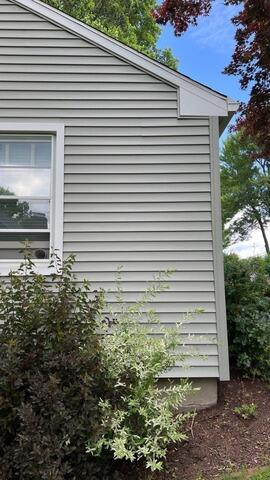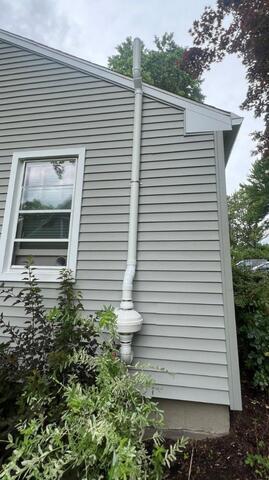Before & After Photos
Click on a photo to enlarge.
Installing a Radon Mitigation System in Southington, CT
This homeowner in Southington, CT called us stating that his home's radon level came out to 9 pCi/L. This is higher than the EPA's radon action level of 4 pCi/L, which concerned him quite a lot. He wanted to install a mitigation system in order to lower his levels as soon as possible. Our radon measurement specialist came out to the home and identified the best spot for the mitigation system.
We were able to help this customer. We installed a radon mitigation system in his home. We began by drilling the holes in the basement -- both in the concrete slab in the bottom and the hole for the exterior penetration. He then began installing the pipes and secured them inside the basement. He installed the manometer on the pipe on the inside of the home. The manometer measures the pressure of the radon in the system, indicating whether or not it is functioning correctly. After that, he went outside to build the rest of the system. He installed the fan on the outside of the home. Once the system was installed, he went back inside, sealing around all of the cracks and gaps in the basement. He also sealed all of the holes that had been drilled for the system. Now, this homeowner has a system designed to keep the radon levels in his home low!
Installing a Radon Mitigation Fan in Westhampton, MA
This homeowner in Westhampton, MA called us hoping that we would be able to help her with her radon mitigation system. She wanted to sell her house, however, the radon system they already had installed was non-functioning. She stated that at one point, the system became quite noisy, so she shut it off. When she went to turn it back on, it would not start.
We were able to help this customer. We replaced her old, non-functioning radon fan with a new one. We utilize many different radon fans depending on many different factors. This home required our Festa AMG Maverick fan. Now, this homeowner has a functioning radon mitigation fan, and she will feel confident listing her home on the market!
Installing a Radon Mitigation System in West Suffield, CT
This homeowner in West Suffield, CT called us hoping to talk about his home. He was purchasing a home, and the home inspection showed that he had a radon level above the EPA's radon action level of 4 pCi/L. Specifically, the radon level was 4.2 pCi/L. This was concerning to the homeowner, and he wanted to get a mitigation system installed as soon as possible.
We had the perfect solution for this customer! We installed a radon mitigation system in his home. We identified the specific space where the mitigation system should be installed. After that, we drilled a hole in the floor as well as a hole in the wall for the exterior penetration. We put together the pipes, starting in the floor, and built it out through the exterior penetration to the outside. We secured the pipes to the wall, and then installed the manometer onto the pipe. (A manometer measures the pressure of the radon gas in the system, indicating whether or not the system is functioning). We then went outside to continue building out the system. We installed the fan and continued building out the pipes, securing them to the outside of the home. Our technician then sealed around the holes that had been drilled for the system. Now, the homeowner has a brand new radon system for their home!
Installing an Energy Recovery Ventilator (ERV) in Feeding Hills, MA
This homeowner in Feeding Hills, MA called us hoping that we would be able to help her with her home. She and her husband were very concerned about their radon exposure. They had recently tested their home for radon. Their levels fluctuated between 2.2 pCi/L and 3.8 pCi/L. While this is under the EPA's radon action level of 4 pCi/L, the homeowner stated that they wanted their radon level as low as possible, and they were quite concerned about their exposure.
We were able to help this customer! We installed an energy recovery ventilator (ERV) in their basement. The ERV we installed was the RenewAire EV90, which is 90 CFM. We anchored a mounting plate to the wall. We then mounted the ERV to the wall. We began connecting the ductwork between the ERV and the outside vents. The intake vent is strategically placed to ensure that the air being brought into the home is the best possible quality -- so it is located away from driveways, as well as anything else that might bring in bad air such as HVAC vents or dryer vents. ERV intake vents are placed at least 10 feet apart from any exhaust vents. We also installed ductwork that brings the old air into the system and pushes the fresh air out of the system. The ERV works by removing stale indoor air from their basement and venting it outside. The fresh outside air gets pulled into the home. While the ERV is running, the temperature and humidity are transferred between the different air streams. For example, as it was a warm spring day, the hot, humid air was being pre-cooled and dehumidified by the air conditioned interior air. In the winter, it would be the opposite -- the cold outside air was being warmed and humidified by the inside air prior to it entering the home. The ERV transfers the temperature and humidity, but does not transfer any larger particles or toxins, which makes it perfect for people who are concerned about their radon exposure. We combined this with a radon mitigation system in order to ensure their radon levels were as low as possible. ERVs are amazing -- able to reduce radon levels 50-75% on average! The homeowners are happy -- they called in the day after the ERV was installed to say that they have already seen an improvement in the air quality in their home!
Installing a Radon Mitigation System in Windsor, CT
This homeowner in Windsor, CT called us hoping that we would be able to help him with his home. He had his home's radon levels tested, and it was testing between 2.48 - 3.12 pCi/L. While this is not over the EPA's recommended Radon Action Level of 4 pCi/L, he still was very concerned about his radon level. He stated that he wanted it "as low as possible", in order to make his home safer and more healthy for his family.
We were able to help this customer. We installed a passive radon mitigation system in his home. We began with finding the ideal spot for the mitigation system. After that, we drilled holes -- one in the concrete slab in the basement and one where the pipe will penetrate to the outside. We then installed the pipe, followed by a manometer. The manometer measures the pressure of the radon gas in the mitigation system, indicating whether or not it is functioning correctly. We then installed the fan on the outside of the home. After that, we sealed the cracks, gaps, and holes in the basement. We tested the system before we left to ensure that it was functioning. Now, this homeowner has a brand new mitigation system to keep his levels as low as possible!












